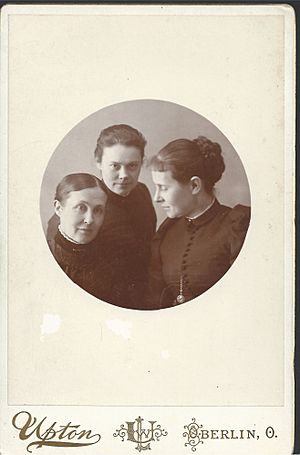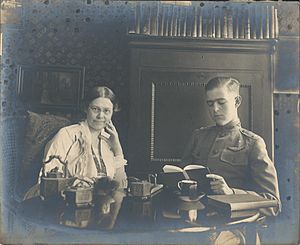Margaret Eliza Maltby facts for kids
Quick facts for kids
Margaret Eliza Maltby
|
|
|---|---|
 |
|
| Born | December 10, 1860 |
| Died | May 3, 1944 (aged 83) |
| Nationality | United States |
| Known for | Measurement of high electrolytic resistances and of the conductivity of very dilute solutions. |
| Children | 1 |
| Scientific career | |
| Fields | Physics |
Margaret Eliza Maltby (born December 10, 1860 – died May 3, 1944) was an American physicist. She was known for her work on measuring how well liquids conduct electricity, especially very weak solutions.
Margaret Maltby made history by being the first woman to earn a Bachelor of Science (B.S.) degree from the MIT university. She had to enroll as a "special" student because, at that time, MIT did not officially accept female students. She was also the first woman to get a PhD in Physics from the University of Göttingen in Germany in 1895.
Maltby was a strong supporter of physics education. She taught special physics classes for people who weren't physics experts. For example, she taught about the physics of music. She wanted to show everyone that physics is exciting and open to all. During her 31 years as the head of the Physics department at Barnard College, Maltby worked hard to help her students succeed in their careers.
She also led the American Association of University Women (AAUW) Committee on Fellowships. In this role, she actively helped women get into physics and find formal education paths.
Contents
Early Life and Interests
Margaret Maltby was born on December 10, 1860, on her family's farm in Bristolville, Ohio. Her parents were Edmund Maltby and Lydia Jane Brockway. She had two older sisters, Betsy and Martha Jane.
As a child, Margaret was very curious about science. She often wondered how nature worked. Her parents encouraged her interest. They taught her how to use basic machines. Her father especially supported her love for mathematics. After her father passed away, her family moved to Oberlin, Ohio, so Margaret could have better educational chances.
While studying at Oberlin College, Maltby also explored her passion for music. Music became a lifelong interest. She enjoyed classical music and later created one of the first college courses about the physics of music at Columbia University.
Education and Research
Margaret Maltby earned several degrees:
- A.B. from Oberlin College in 1882
- A.M. from Oberlin College in 1891
- B.S. from Massachusetts Institute of Technology (MIT) in 1891
- Ph.D. from University of Göttingen in 1895. Her advisor was Walther Hermann Nernst.
In 1887, Maltby started at MIT and got her B.S. degree in 1891. She was the first American woman allowed to pursue a graduate degree at the University of Göttingen in Germany. She was also the first woman to receive a Ph.D. in physics from Göttingen. In fact, she was the first woman to get a physics Ph.D. from any German university!
After getting her doctorate, she worked at a new physical chemistry institute in Göttingen. In 1898, she was invited back to Germany. She worked as a research assistant and helped set up research methods for studying how well materials conduct electricity. After returning to the United States, Maltby studied mathematical physics at Clark University.
Career Highlights
Margaret Maltby had an impressive career:
- 1889-93: Instructor in the Physics Department at Wellesley College
- 1893-96: Doctoral Student and Research Assistant at the University of Göttingen
- 1896-97: Associate Professor in the Physics Department at Wellesley College
- 1897-98: Instructor of Mathematics and Physics at Lake Erie College
- 1898-99: Research Assistant in Charlottenburg, Germany
- 1900-03: Instructor in the Chemistry Department at Barnard College, Columbia University
- 1903-10: Adjunct Professor in the Physics Department at Barnard College
- 1910-13: Assistant Professor at Barnard College
- 1913-31: Associate Professor and Chair of the Physics Department at Barnard College
Supporting Women in Science
Most of Maltby's important research happened before she started teaching at Barnard College. Her work as an administrator there left her less time for research. However, she became a great mentor to her students. She worked hard to help them advance in their careers. During her 31 years at Barnard, and nearly 20 years as head of the physics department, Maltby cared deeply about her students' learning. She even created physics courses for non-physicists, including what was likely the first course on the physics of music.
Maltby strongly supported women in physics. As the head of the American Association of University Women (AAUW) Committee on Fellowships, she managed money that helped women doing physics research early in their careers. These AAUW Fellowships were very important. At the time, women often couldn't get many research fellowships because of their gender. Maltby's hard work helped keep these fellowships going.
Barnard College had a rule that said the college didn't want women on staff who put home duties first. But Maltby supported women who wanted to have both a career and a family. As head of the Physics Department, she strongly disagreed when Harriet Brooks was forced to resign because she planned to get married.
Physicist and historian Katherine Sopka wrote that Maltby's students really looked up to her. One student said that Professor Maltby was a "gracious lady" and a "friend and counselor." Maltby herself never married.
In 1906, the first edition of American Men of Science recognized her as one of the country's top scientists.
Honors and Recognition
Margaret Maltby received many honors for her achievements:
- First woman to get a Ph.D. in physics from Göttingen University, 1895
- American Association of University Women European Fellow, 1895–96
- Fellow of the American Association for the Advancement of Science, 1889
- Fellow of the American Physical Society, 1900
- Her name appeared in the first seven editions of American Men of Science, starting in 1906
- The Margaret E. Maltby Fellowship was created by the American Association of University Women in 1926
Personal Life and Family
Margaret Maltby never married. However, she experienced the joys of motherhood and grandmotherhood. In 1901, she welcomed a son, Philip Randolph Meyer, into her life. He was born in 1897.
After leaving her teaching job at Wellesley College in 1896, Maltby returned to teaching at Lake Erie College in 1897. She then took a research position in Germany in 1898. During this time, her son was cared for by a friend. When she returned to the United States in 1901, she was reunited with her son and began her work at Barnard College.
She spent most of the rest of her life in the Columbia University area in New York City. She took a year-long break to study at the Cavendish Laboratory in Cambridge University in 1910. She also enjoyed frequent and extensive travels.
Death
Margaret Maltby passed away on May 3, 1944, at the Columbia-Presbyterian Medical Center in New York City.
See also
 In Spanish: Margaret Eliza Maltby para niños
In Spanish: Margaret Eliza Maltby para niños



